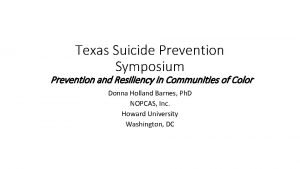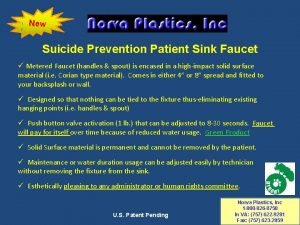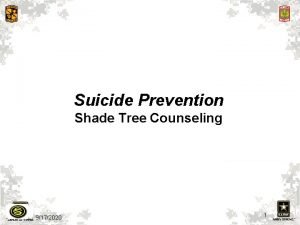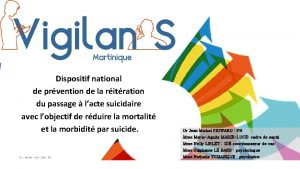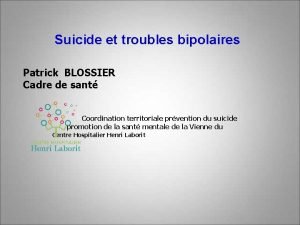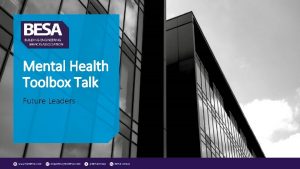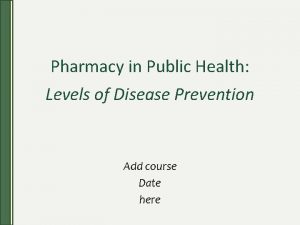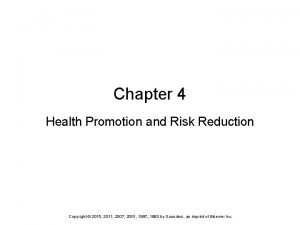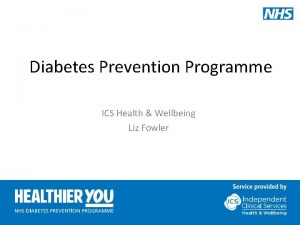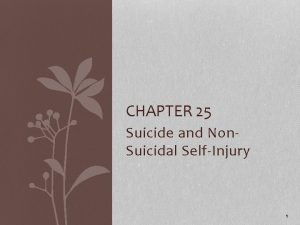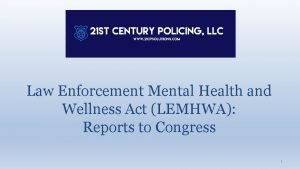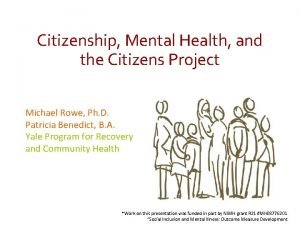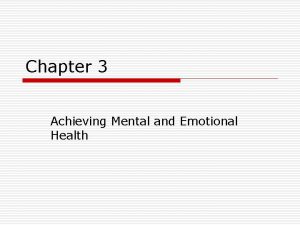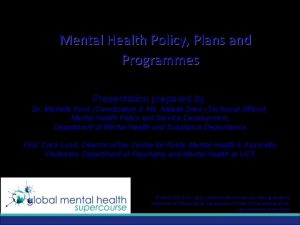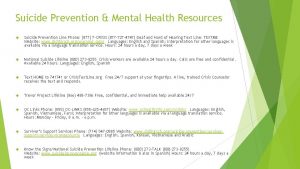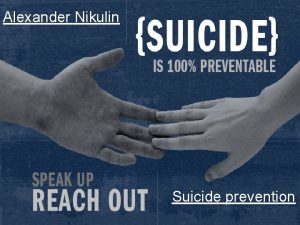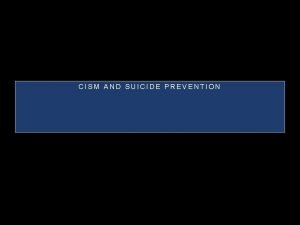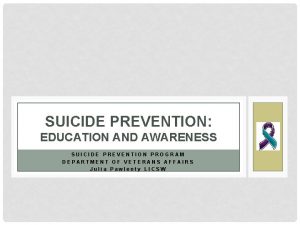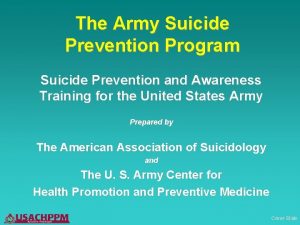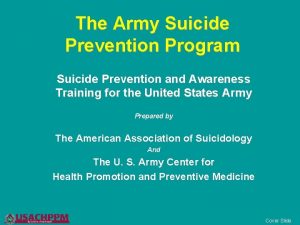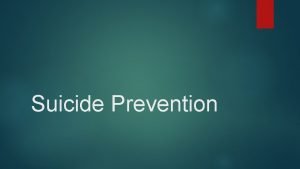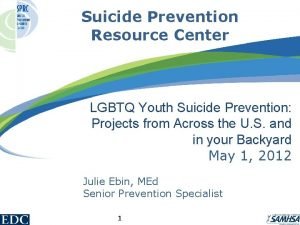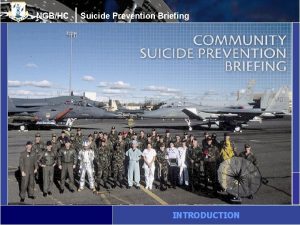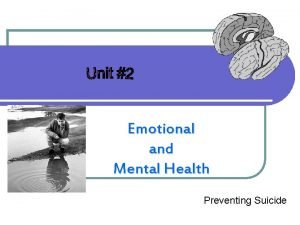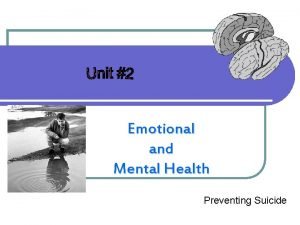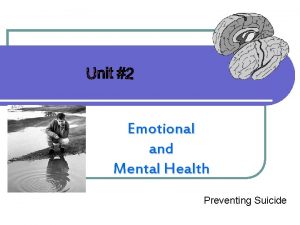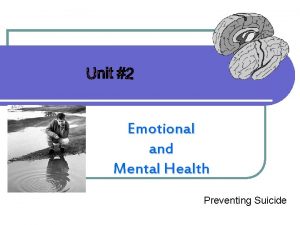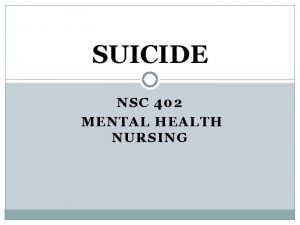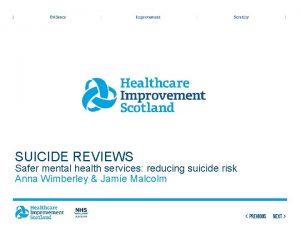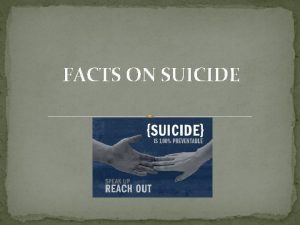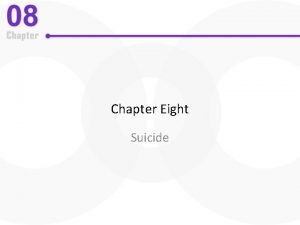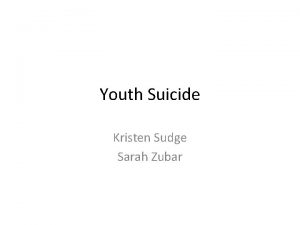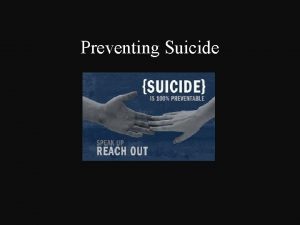MENTAL HEALTH AND SUICIDE PREVENTION IN THE CONSTRUCTION




























- Slides: 28

MENTAL HEALTH AND SUICIDE PREVENTION IN THE CONSTRUCTION INDUSTRY August 27, 2020 Presented by Stuart Binstock President & CEO Construction Financial Management Association

Objectives • Why do we need to address mental health and suicide prevention in the construction workplace? • How can mental health and suicide prevention be woven into existing safety, wellness and performance management practices? • How does suicide prevention integrate with bringing additional employees into the work force? • How can you measure your company’s suicide prevention preparedness and culture? • What resources are available through the Construction Industry Alliance for Suicide Prevention?

“We don’t have a mental health or suicide problem…”

1008 Construction Worker Fatalities in 2018 9. 5/100, 000 rate Estimated 5, 242 Construction Worker Suicides in 2018 49. 4/100, 000 rate

48, 344 Deaths by Suicide Overall 14. 2/100, 000 132 Per Day Attempts for each suicide death 112 Lives Impacted by each suicide 2 x times more likely to die by suicide as a survivor of a loved one who dies by suicide 25 2018 Statistics per CDC

WHY IS THE INDUSTRY’S SUICIDE RATE SO HIGH? Workforce Demographics • Men, especially white men from their early 20 s through their 50 s, account for the bulk of suicides • Male-dominated industries tend to have more suicides • According to the Bureau of Labor Statistics, 97. 4% of the U. S. construction workforce is male and 56. 9% of the U. S. construction workforce is Caucasian

WHY IS THE INDUSTRY’S SUICIDE RATE SO HIGH? Nature of the Work/Work Culture • Stoic, “old school” and “tough guy” culture • Fearlessness and “thrill seeking” • Promotion of supervision without leadership training • Family separation and isolation with travel • Sleep disruption/deprivation due to shift work • Seasonal layoffs and end-of-project furloughs • Tolerant culture of alcohol and substance abuse • Chronic pain • Industry with highest use of prescription opioids • Performance pressure (schedule, budget, and quality) • Access to lethal means

The good news – there is HOPE Suicide IS Preventable

90% of Suicides are by individuals with an underlying mental illness Depression is the first leading cause of disability & increases risk of other chronic medical conditions – Mental health claims are 1/3 of all disability claims

Mental illness leads to $193 billion of lost earnings 1 in 5 Adults Will Experience Mental Illness 43. 8 Million 60% are left untreated 6. 9% Depression 18. 1% Anxiety Can lead to up to 27 lost workdays per year

A $1 Investment in mental health results in a $4 Return on Investment 33% of Workers Comp claims in men & 66% in women had an existing mental health condition 50% report symptoms of depression in the month following an injury Nearly half have a co-occurring substance abuse disorder

“We’re focused on other employee recruitment and wellness initiatives…”

“We don’t know how to get started…”

History of CIASP The Construction Industry Alliance for Suicide Prevention was founded in 2016 to promote mental health wellness and to raise awareness about suicide prevention. September 2019 CIASP launches independent website. April 2019 CIASP holds its second strategic planning meeting in Washington DC along with a meeting of task forces and a meeting with the Department of Labor and OSHA to explore opportunities to promote suicide prevention through federal programs. October 2016 Construction Financial Management Association (CFMA) forms the Construction Industry Alliance for Suicide Prevention. July 2016 Centers for Disease Control and Prevention study examines suicide risk by profession revealing “people who work in construction and extraction had the second-highest rate of suicide. ” November 15, 2018 June 2016 CDC releases report with the construction and extraction industry named as being the most at-risk Construction Financial Management Association’s (CFMA) Annual Conference includes sessions on industry for suicide. mental illness and suicide September 25, 2018 April 2016 CIASP holds first strategic planning meeting in CFMA’s Valley of the Sun Chapter hosts first regional Washington DC. Suicide Prevention Summit August 3, 2018 November/December 2015 CIASP becomes a nonprofit organization. CFMA publishes “Mental Illness & Suicide—Break the June 2018 Silence & Create a Caring Culture” in CFMA Building CDC reports a 30% increase in suicides in half Profits, written by Cal Beyer and Dr. Sally Spencerof states since 1999—nearly 45, 000 lives lost to Thomas suicide in 2016.

www. PREVENTCONSTRUCTIONSUICIDE. com

GET HELP. Encourage your company to: • Make public the National Suicide Prevention Lifeline and Crisis Text Line information on jobsites and in the office in the event someone is in immediate risk of suicide. • Learn to recognize the warning signs of someone who may be at risk.

Know the Warning Signs Recognizing warning signs—through conversations, social media posts or changes in behavior—may help determine if someone you know is struggling. HAVE YOU OR SOMEONE YOU KNOW EXHIBITED ONE OR MORE WARNING SIGNS? • Feeling sad or depressed most of the time • Talking about feeling trapped or wanting to die • Extreme mood swings • Increased use of alcohol or drugs • Decreased self-confidence • Feeling hopeless and helpless • Sleeping too much or too little • Feeling anxious, agitated or reckless • Withdrawing from family and friends • Talking about being a burden to others

Know the Warning Signs Recognizing warning signs—through conversations, social media posts or changes in behavior—may help determine if someone you know is struggling. WARNING SIGNS SPECIFIC TO CONSTRUCTION WORKERS INCLUDE: • Decreased productivity • Increased conflict among co-workers • Near hits, incidents and injuries • Decreased problem-solving ability • Increased tardiness and absenteeism

Tune in Know How to Respond: TASC Ask State Connect Tune in: When you notice or sense that a person may need help, focus your attention on them for warning signs Ask: Ask if they are thinking about suicide clearly, directly & calmly – and without judgement State: State that suicide is serious and that connecting to help is important Connect: Connect the person to a helping resource who knows suicide first-aid skills

HOW TO EVALUATE A COMPANY’S MENTAL HEALTH & SUICIDE PREVENTION PREPARDENESS & CULTURE

Corporate Culture Resources Readiness To Assist Employees in Need Proactive Factors Crisis Response

GET INFORMED. • Understand why construction is the most at-risk industry for suicide. • Incorporate training, such as Living. Works Start, an online training program that teaches people what to look out for and how to connect someone to help. • Take a brief, anonymous online screening to check-in on one’s behavioral health, connect to local resources, and work toward recovery.

GET STARTED. Encourage your company to pledge to STAND up for suicide prevention and address it as a health and safety priority by creating safe cultures, providing training to identify and help those at risk, raising awareness about the suicide crisis in construction, normalizing conversations around suicide and mental health and ultimately decreasing the risks associated with suicide in construction.

GET STARTED. Integrate suicide prevention into your company culture. • Incorporate toolbox talks on psychological safety topics. • Print and distribute wallet cards with warning signs and helplines. • Hang posters in work trailers, breakrooms or on company billboards that address suicide and mental health, Employee Assistance Programs, and other mental health services.

COVID-19 Resources The Construction Industry Alliance for Suicide Prevention shares the global concerns over the COVID-19/Coronavirus impacts being experienced by many. Employers have a key role to play in not only taking care of their employee’s physical health and safety at this time, but also their mental health. This is a stressful event and not everyone is able to cope with the added stress, worry and confusion. Please use these resources to educate yourself and equip your employees to get through this challenging time. QUICK LINKS General COVID-19 Resources from the American Foundation for Suicide Prevention Labor Union Information and Resources Laborers' Health & Safety Fund of North America (LHSFNA) Resources

What can your company do? • Take the pledge to STAND up for suicide prevention • Host a suicide prevention Toolbox Talk • Take advantage of discounted education through Living. Works Start program • Donate to the Construction Industry Alliance for Suicide Prevention


THANK YOU!
 Primary prevention secondary prevention tertiary prevention
Primary prevention secondary prevention tertiary prevention Mad acronym suicide prevention
Mad acronym suicide prevention Glencoe health chapter 5 mental and emotional problems
Glencoe health chapter 5 mental and emotional problems Suicide prevention chain teach
Suicide prevention chain teach Texas suicide prevention symposium
Texas suicide prevention symposium Suicide prevention sink
Suicide prevention sink Army suicide prevention situational questions
Army suicide prevention situational questions Prévention du suicide
Prévention du suicide Suicide prevention month quotes
Suicide prevention month quotes Army suicide prevention training
Army suicide prevention training Vivien blossier
Vivien blossier Mental health and mental illness chapter 20
Mental health and mental illness chapter 20 Mental health jeopardy game
Mental health jeopardy game Mental health toolbox talk construction
Mental health toolbox talk construction Construction site theft prevention
Construction site theft prevention Health promotion and levels of disease prevention
Health promotion and levels of disease prevention Health promotion and levels of disease prevention
Health promotion and levels of disease prevention Ics health & wellbeing
Ics health & wellbeing The sad persons scale
The sad persons scale Chapter 3 lesson 3 expressing emotions in healthful ways
Chapter 3 lesson 3 expressing emotions in healthful ways Mental health and older adults
Mental health and older adults Law enforcement mental health and wellness act
Law enforcement mental health and wellness act Mental health and older adults
Mental health and older adults Mental health and citizenship
Mental health and citizenship Chapter 3 achieving mental and emotional health
Chapter 3 achieving mental and emotional health Chapter 21 mental health diseases and disorders
Chapter 21 mental health diseases and disorders Glencoe health chapter 3 lesson 1 answers
Glencoe health chapter 3 lesson 1 answers Psychology, mental health and distress
Psychology, mental health and distress Mental health policy, plans and programmes michelle funk
Mental health policy, plans and programmes michelle funk




